“Sell ticker rain jurrs, wee chwonn?!” Said he. “Huh? Oi dahnd unnerstehnn wotcha saiyin!” Said I. It was my first day at primary school in Glasgow and a mutually unintelligible clash of regional English accents was under way; Glasgow Scots vs Rural Aussie. Like me, the other kid was a knock kneed 9 year old Celt, but wearing a belligerent expression on his pasty dial, and I had no idea what his agitation was about.
Another ginger haired Scots tyke told him that my incomprehension was because I was Australian, at which my stroppy interrogator huffed off someplace, muttering (I think) about kangaroos. Dad later decoded this tense exchange after school, as we trudged home along the Crow Road, shivering in the clammy gloom. (Nightfell as early as 3:45pm in winter, meaning that it was twilight when I got out of school, and pitch dark by the time I’d walked home). Dad said that my adversary had been asking “Celtic or Rangers, which one?!” but this was still utter gibberish to me, even when I understood the individual words. Dad explained that the boy’s question had challenged me to swear allegiance to either of two local soccer teams who were mortal enemies. What I know now but didn’t yet understand back then was that the important subtext of the question was that one of these teams was historically Catholic and the other was Protestant, and my inability to understand the question had probably saved my head from being punched in, as I was Catholic. The wrong answer in that area. More to the point, I didn’t (and still don’t) give a toss about sports anyway, but as luck would have it, I’d soon assert myself as a soccer savant purely by accident.
The school had one soccer pitch where multiple games were played concurrently during our lunch break. Exactly how many only became clear by counting the number of goalies in each goal mouth, often upwards of four. These kids had to make sense of multiple matches and call any game headed toward goal as “MINE!” when other goalies would briefly step aside to let him face the oncoming storm. I was running in this swirling melee myself, trying to understand crisscrossing swarms of tykes in the exact same school uniform kicking a multitude of soccer balls every which-way, when a ball cannoned out of nowhere, savagely caromed off my face and into goal. By pure luck, it was the ball from the game I was associated with and won a point for my team. With ears still ringing and my face throbbing five shades of red from chin to hairline, I did my best to pass off this fluke as a famous Australian header technique, and was hailed as the athletic hero of the day by one and all. I further cemented my schoolyard network when it turned out that a few classmates were Cub Scouts.
I had been a Cub Scout in Australia, and after my family moved to Scotland I joined a Cub Scout pack near our new home in Glasgow. I was a novelty right away because of my old style blue uniform and distinctive Australian merit badges. The Scots wore khaki/green outfits and their way of denoting rank was ARROWS on the sleeve (like sergeant’s stripes) whereas in Australia it was BOOMERANGS. I’d earned a bronze boomerang by accumulating a few art/craft merit badges and my one great Cub Scout achievement; raising the most money in a ‘Bob a Job‘ fundraiser. In every other field of Cub Scout endeavour, requiring bushcraft or physical coordination, I was mediocre at best. Like a dog pack, a Cub Scout pack could sniff out the status of other Cubs by merely looking at this resume of little boy achievement on our uniforms. (If this merit badge system continued into adulthood you’d know immediately if your date was worth your time by his ‘Good Boyfriend‘ badge — semiotic icon: peeing with seat UP). In my brief time in Scottish Scouts I attended weekly meetings where two grown men referred to as ‘Akela & Baloo‘ (in kilted scout outfits) tried to channel the energies of their pack of little wolves toward the high minded ideals of the organisation (a lot of ‘Queen & Country’ bollocks in hindsight) while the pack itself often focused on a simmering rivalry with a similar organisation of tribal brats a few blocks away (that variation on the ‘Lord Of The Flies With Supervision‘ concept was called Boys’ Brigade).
The main memory I have of my time in Scottish Scouts is of a several-day trip to the Scottish Highlands. After a bus drove us Cub Scouts all the way up there, we slept in a large empty hall, rather than tents as I’d done at similar Jamborees in Australia (called ‘Coroborees’ down our way) but inside camping worked well in the Highlands, as the weather was shitty most of the time, and the pack went rambling on moors and craggy coastlines between intermittent downpours. One afternoon we Cub Scouts were dodging rain and amusing ourselves back at the hall when I noticed a concerned huddle of Akela & Baloo. They glanced furtively at me and discussed some paperwork, before quietly taking me aside and asking me; “are you Catholic?” in hushed tones of concern and fear, as if asking “do you have ebola?” Weeks earlier my parents had filled out a permission form for me to go on the trip, with the usual stuff (medical issues, allergies, and so on) and even though the religion section clearly stated that I was Catholic, Akela & Baloo appeared to need further verbal clarification from me to believe this particular detail (apparently unnoticed until we were already on the trip). Upon careful consideration, I had to admit that I wasn’t exactly sure, but; “Maybe I might be Catholic?” Their tension eased a little; “So your family doesn’t go to church, then?” they enquired. “Oh no“, I corrected, “We go every Sunday“. Their shoulders sagged. “Where?” I described the drive from our house in Glasgow to our church, and Akela & Baloo drooped even further, exchanging looks. They seemed to know where I meant, but I could not decode their reaction.
At the time, I was oblivious to the pickle that me & my form had dropped them in. I did not yet understand the distinction between ‘Catholic’ and ‘Protestant’ at the age of 9, but in Britain of the early 1970s, with the IRA tossing bombs about the place, and Catholics being occasionally shot by military forces in Northern Ireland, it was a very important distinction indeed. Later that same year my family saw ground zero of this Catholic/Protestant clash in Belfast. I still have jagged impressions from that day, of a broken grey town, spooled with barbed wire, patrolled by grim-faced troops wielding machine guns & driving Saracens, all seen through the wide goggling eyes of a small boy from a small town half a world away. At numerous checkpoints our family car full of 4 tiny children was inspected by armed soldiers, as my family drove through Belfast on our way to connect with a ferry back to Scotland. It was the first time I’d seen a real machine gun, and by the end of that day I’d seen quite a few. 21st century Britain is afraid of Muslim terrorism, but in 1974 Muslims were simply the people who sold us comics and sweeties at our corner store, and terrorism was the exclusive speciality of Catholics.
These many years later, I understand this context for the furtive glances and kid gloves that Akela & Baloo handled me with back then, when I was a little boy; Catholics were clearly testy nutjobs, and God only knew what the Australian variety might be capable of. Better find this kid a Catholic church pronto, unless his roo-riding parents launch an Aussie Left-Footer fatwah on the Jordan Hill scout hall. However, even in Glasgow we had to drive a long way from where we lived to attend a Catholic church (I remember my family picnicking near this church after mass, when a throng of angry blokes in orange shawls appeared. “What are those men yelling about?” I asked Mum & Dad. “Us!” they replied, as Mum gave me my sticky bun). Way up in the remote Highlands, Akela & Baloo had less options for finding me the right flavour of church to kneel in.
That Sunday we Cub Scouts got up VERY early before church and went for a long drive in our bus out into the beautiful heathered bleakness of a Scottish Highland moor. To my surprise, the bus stopped at an intersection out in this barren landscape and Akela gestured at a tiny rustic chapel, saying this was the right church for me, that they would pick me up after mass, and to please be patient as it might take a while. I got off the coach and walked over to the tiny stone chapel out in the backside of beyond, as my Cub Scout pack zoomed away to attend their own brand of Church on time. Imagine that classic scene in a western where all the owl hoots in the Dodge City saloon turn to see the new gunslinger walk through the swinging saloon doors. Now substitute the dusty saloon with a tiny rundown chapel on a Highland moor, for the piano player swap a Celtic crone seated at an organ, replace the bar patrons with a few elderly parishioners, and the new kid in town standing backlit at the door is me, in my garish Cub Scout uniform. Thinking back on it now, I must have been a bizarre sight from the point of view of these Highland parishioners waiting for mass. Outside they’d heard the squeal of brakes, the pneumatic hiss of an opening door, and turned to see a solitary sawn off creature in blue crossing their threshold.
In total silence I took a pew at the very back of the tiny chapel and waited. Slowly, more craggy Highlanders came in and took their seats. It was only then that I realised I’d broken with some local protocol. Unlike my parish, these Highland Catholics preferred that all lads sit on one side of the aisle and all lassies on the other, and I had been sitting amongst the womenfolk (though I fixed my mistake after communion). When the service got under way I had great difficulty in understanding what was being said. I’d eventually learned the rhythms of Glasgow speech, but this Highland Scots accent was impenetrable to me. It occurs to me only now that the service may have been in Gaelic, depending on where I was, but I couldn’t even guess where it might have been. Wherever I was, it was a long way from everywhere else, and my Cub Scout pack had gone well out of their way to get me there. Thankfully, although the priest’s words were opaque to me, I knew the rhythm of a Catholic mass by heart, and when to stand, sit, kneel, mumble or be silent.
After the mass ended, the tiny congregation quickly dispersed and hobbled away into the mist. I’m racking my memory as hard as I can now to remember if anyone queried me after mass. Even though it seems reasonable that somebody might be curious to know the identity of the mysterious tiny stranger in the blue uniform festooned with arcane symbols, I don’t have any recollection of even one of this taciturn crew talking with me, not even the priest. Let’s assume however that the good Father did check in with me, if only briefly, and after I assured him that I’d be picked up presently, he too hightailed it back into the Highlands. Thereafter, was a very long wait in the misty middle of nowhere until the rest of my Cub Scout pack returned.
Later, when I got back to Glasgow and Mum & Dad heard about Akela & Baloo’s furtive pre-church interview, the efforts my Cub Scout pack had taken to get me to a Catholic church, get to their own mass, and then drive back to pick me up, it became clear that none of it was necessary. Though touched by these efforts, Mum & Dad wouldn’t have minded in the slightest if I’d been taken to a church of another denomination. However, Akela & Baloo had never encountered someone of my peculiar breed in their Cub Scout pack ever before, and decided the best policy at the last minute was to be sensitive to causing offence. Everywhere in Scotland was a clan and/or a feud. Were you Catholic or Protestant? Celtic or Rangers? Campbell or MacDonald? Cub Scout or Boys Brigade? Highlander or Sassanach? Akela & Baloo clearly knew the protocols of dealing with Scots clans, and erred on the side of caution.
Our school too was divided into clans of a sort, the separate competing school houses (Harry Potter style). My schoolmates with classic Scottish surnames displayed their traditional clan tartans with utmost pride, on scarves, socks, hats, and other clothing accepted in school uniform rules. Not just clans, but hierarchies too were important. As a school newbie, I initially sat in the seat closest to the classroom door, and it took me a while to understand why the teacher (a fierce though loveable Scottish war hammer who could’ve been the model for Professor Minerva McGonagall) would rearrange our desks every fortnight. I eventually learned that placement of students within the classroom denoted their academic rank (a variation on the the at-a-glance merit badge ranking system used by Cub Scouts). Everyone knew exactly where you were within the hierarchy based on seating order; the front seat closest to the door (where I’d started) was for dummy numero uno, and the kid sitting over by the window at the back was class brainiac (for the record, I’d almost climbed to my traditional academic sweet spot of ‘the middle’ by the end of my time in Scotland).
With this pecking order humiliatingly displayed for all to see, each child asserted their own hierarchies in constantly revised lists taped to the underside of their desk lids. Not just the standard lists of fave bands, movie stars, athletes, and so on, but also best friend lists. These were prominently displayed as each student opened their desks to retrieve a book, when surrounding classmates would check to see whether their own currency had risen or fallen in these multiple social stock exchanges. My own ranking, if I made any lists at all, was once again ‘bottom of the middle’. It was all a lot to keep track of; the ‘LIKES’ of 1970s social media.
It was while in Scotland that I learned about British comics (such as Valiant, Beano & Dandy) and my drawing made a quantum leap as a result. I eagerly digested daily TV helpings of Brit Sci-Fi (Doctor Who, Space 1999, UFO) and Supermarionation (Captain Scarlet, Joe 90 and Thunderbirds). In Scotland I belatedly learned to ride a bicycle, camped by Loch Ness (fervently seeking Nessie) visited real castles and torture dungeons, and was impressed by many other things that made indelible impressions on a little boy. But my time there was extra special for personal reasons too. Though raised in Australia by Australian parents, I’d actually been born in Scotland (in Edinburgh while my father studied there) and my mother was of Scots ancestry on her father’s side. She was a STUART (clan Stuart of Bute) and during the year I turned 10 years old and my family briefly lived in Glasgow, I learned about my mother’s clan so fierce and proud; THE SCOTS.
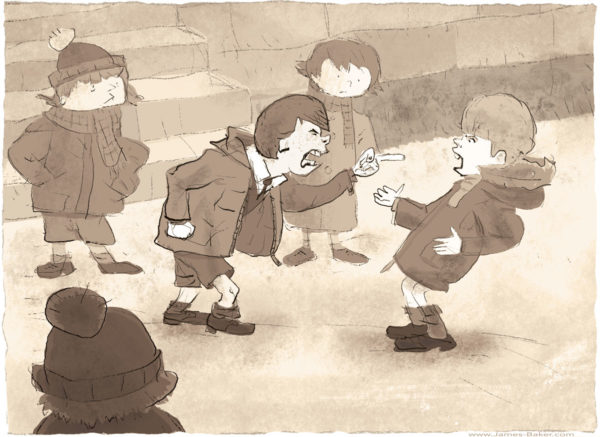
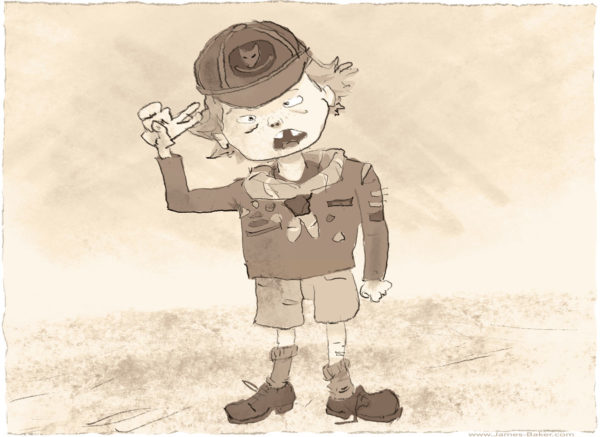
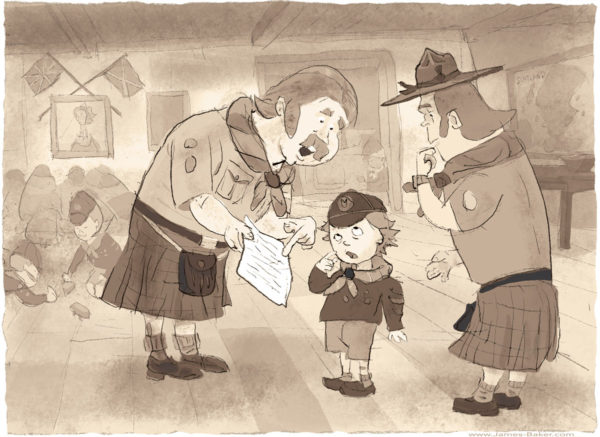
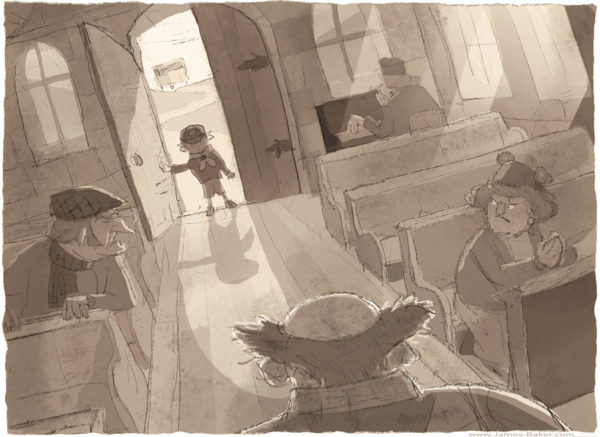
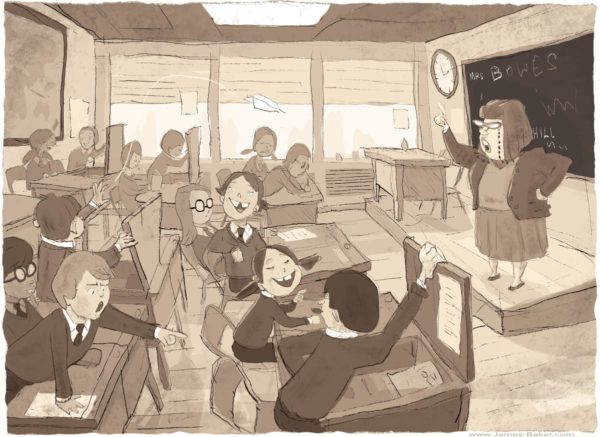
Awesome story and drawings James!
Thanks, Sean. Scotland gave me some of the most vivid memories of my childhood.
Travel at a young age can have profound effects, my son Liam was deeply effected by our sojourn in Japan when he was just turning four, influenced him ever afterwards.
Agreed Sean. There have been several times when I’ve heard friends opine that travel is wasted on young kids but I can vouch myself that it had a profound effect on 9 year old me.
Jamie rules!
Ha ha!
Trying to imagine the messed up kingdom my broken gimpy ass could rule. ARS-TEROS
Arseterhoids?
I think that soccer move is called the,”Ozzie Facial”
The “Downunder Blunder”!
That one makes me laugh and gets me choked up at the same time. Lovely story. 💖
I was only there for a few months but have many memories as a result. Part of it was the fascination of returning to the place where I was born and where my mother’s people came from, I think.
Dear Jamie,what a great story.Beautifully done.I was south of the border and didn’t go to church until later(13 years) but at school we were forced to attend every day and twice on Sunday!The Beano, Dandy,Dr Who and Thunderbirds were all a go!❤️🙏Robbie
Robbie! That year I spent in the UK (I also spent time in KENT later that same year) was a real eye-opener. Loved Brit pop culture. Of course we get exposed to some of it down in OZ, but that year I was at ground-zero and standing in it!
Great story my friend.
Thanks, John.
James – thanks for the post and the update! Re: the Catholic/Protestant issue: i saw a bit of the same while in Ireland working for Bluth, but not nearly through the terror of youth like you!
As for Glasgow, got over there to visit wee Fraser MacLean recently, loved it. Hope to go back again soon. keep up the great work! – scott
I never was really put in a dire Catholic/Protestant situation myself, but gradually became aware that it was a cause of great anger to others. The 1970s were a bad time for that issue, but I was removed from it, in a way, by my childish ignorance.
I was surprised at how clean Glasgow looks now when I went there as an adult. Back in the 1970s most of the buildings still carried a thick coat of industrial black grime that was sandblasted off later, revealing astonishingly pretty architecture that was gothically grim when I was there.
So great. I like how you call them “vivid” memories, but the sketches make it look like a misty, a tea stained, damp world. Did they have Scots accented Indians in the curry shops back then?
That’s really what it looked like; misty and tea stained. Yeah. And the women really DID look like Alec Guinness in a dress. True.
Just wonderful.
Mah people!
In a story about hierarchies, it’s a shame no one seemed to recognize that boomerangs are so much cooler than arrows!
Ha! Well my patches actually did gain me some notoriety, briefly.
Thanks a bunch, dear Boy, for this heart-string virtuosity piece, and not the least for the brilliantly evocative illustrations fitting its moods like a finger in a glove. The general outlines of your 1974 experiences in Scotland, and later in Orpington (what about a piece on the Mr Hillman phenomenon and all that?) were known to me, but never so movingly realised as in this brilliant re-evocation. And I’m pretty sure I’m right in saying that, to this very day, I’d not known about your Facer into the goal-mouth at Broomhill Primary. Please keep up this sublimely entertaining line of text and illustration
Love to both of you from both of us, Dad
Yes, I may write about Orpington too some day. You probably had not heard about my soccer FACER manoeuvre, because at the time it was clear to me that my schoolyard reputation as an athlete was all based on a LIE.
ha ha!
By the way, do you happen to remember where I went on that Cub Scout trip? In my memory it was way far up in The Highlands, but maybe it was simply around Inverness.
Lovely story and drawings, my family come from Scotland , always mean to back and visit 😊
Oh yes? I did not now that. What is YOUR clan, Roz?
James Baker We are The Hunter’s Clan with a lovely green tartan !!! From my mothers side 🙂
My Mum didn’t like the pattern of the Stuart tartan, so when she bought me a kilt it was of some other clan, simply because she liked the look of it!
Haha!!
Another great story, I love reading these Jamie;)
Thanks Gale. I have quite a few more that I’d like to do. Stay tuned!
I love your stories, your a wonderful writer and artist … I enjoy them so much 🙂
Thanks Lianne. When I get enough I’d like to assemble a little book collection of childhood stories. Maybe another, later, of my travel adventures.
That’s an awesome idea, you should absolutely do it… I would love to have both of those books 🙂
Nice one James. Go Beechwood!!!!
Ha ha! Yes. “Beechwood”, “Randolph” and “Ashcroft”, (I think). I used to know the words to the BROOMHILL school song but it’s mostly gone now..
HA The scene in the little remote Highland church would be a great opening scene for your screenplay! Highly entertaining read as always Jamie – so glad we crossed paths all those many halcyon years ago.
Yes, a little bit of Morricone (with a bagpipe in place of harmonica) and you’re done!
Beautiful brother
Thanks Robbie. Over these past few years writing such stories has been a fine way to while away the time, and illustrating them has been fine practise for drawing with my LEFT hand.
Love the flinty congregation that couldn’t bother giving an alien Cub Scout clearly on his own event just ‘Well hello, what brings you here?’ – probably viewing that as some kind of hand out – an off-brand outsider kid expecting eye contact to leverage some unearned and so undeserved human decency out of them. Tho she’s rural Canadian, Alice Munro is also Scottish and her books are full of this kind of apparent skinflint coldness and characters trying to crack it or pretend it’s something else while learning there just isn’t an ounce of generosity there.
Or maybe they’d all just put off their wake-up toot or two until after church because it was Sunday?
How this shit dovetails with The Scottish Enlightenment I’ll never know.
Thanks Jamie, great story.
I have quite a few memories that I didnt think much about at the time, but looking back at them now as a grown-up I realise that some of the adults in these memories were behaving atrociously badly. In particular, I have many memories of nuns, priests, and brothers (who taught me as a child) being utter arseholes.
Brilliant as usual James, a beautiful piece of writing accompanied by such sweet illustrations.
The story made me feel like I was you there and then.
Time to seek a publisher methinks?
A.
I’d love to get these published someday.. First, I’d like to accumulate more though. Thanks for reading commenting, Arthur!
Another great tale James Baker. Thanks for sharing.
Glad you liked it, Peter.
That Church sounds like a Highland Catholic Wicker Man cult situation to me. Your lucky you didn’t get sacrificed on Scots thistle pyre.
To be sacrificed, they’d need to actually INTERACT with me, and that was the last thing they wanted to do. It was more like that scene in old cowboy movies where the stranger rides into town and windows close and doors slam. “we don’t kindly to yer type around these here parts, stranger..”
Your writing talent rivals your artistic talent. I’m reading a lot of Wendell Berry lately, and you’ve changed my mind about him being the best I’ve read.
Thank you.
Great, and touching, story Jamie. The illustrations are wonderful. The church scene is my favorite. Yes, a book of such tales is a worthy project.
Yeah, I think the CHURCH scene was my fave too (the Scoutmasters in kilts was maybe my second fave). Thanks for reading and commenting, Bill.
I love this!
Thanks Sam. I should have more childhood yarns later.
Great story, love the imagery and the illustrations are beautiful. Hopefully the sullen church people don’t represent us Scots as a whole
https://t.co/kTTdtOLHcy
Ha Ha! My time in Scotland was GREAT, but yeah, that was a grim little crew. Thanks for reading!